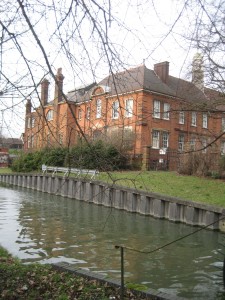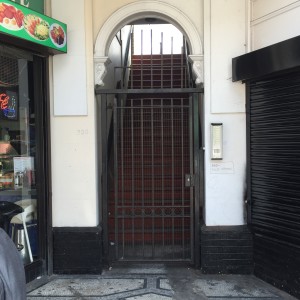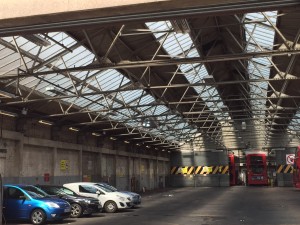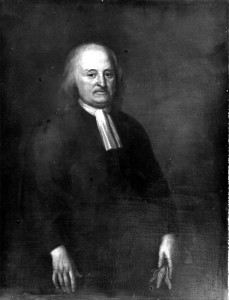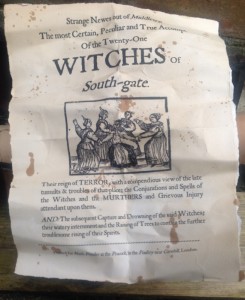315 -397 Green Lanes, 288 Green Lanes, 286 Green Lanes
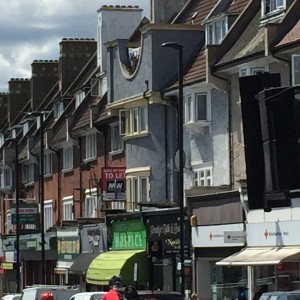 If one man above all others could be said to have shaped the look of central Palmers Green it would probably have to be Arthur Sykes.
If one man above all others could be said to have shaped the look of central Palmers Green it would probably have to be Arthur Sykes.
Sykes was the architect of the amazing and fanciful parade on the west side of Green Lanes up to Devonshire Road and the Grade 2 listed National Westminster Bank on the east side – according to Pevsner, Palmers Green’s gems amid ‘a poor man’s Muswell Hill’. He was also responsible for the more restrained 286 Green Lanes, now home to ubiquitous burger flippers McDonalds.
Born in 1862, Sykes came to London in 1883 to the offices of Sir Robert Williams Edis, but had already set up on his own by the age of 26. Though he built the home of Lilley (of Lilley and Skinner fame) in Clacton, he spent much of his career in designing buildings primarily for the purposes of business and retail. Such skills were much in demand – the turn of the century saw purpose-built parades and arcades springing up all over London, including Muswell Hill, Crouch End, Streatham and Bromley.
For the most part, based on the larger buildings still extant, Sykes’ style seems to have been dignified and restrained, often with a slightly Italianate or classical bent. In 1899-1901 he was commissioned to design huge premises for Pontings in Kensington. Six stories high, including two floors in the mansard roof, the new Pontings cost £14,000, an astronomical figure at the time. 1905 saw another substantial Sykes designed building, Kingsway House, springing up in Holborn and in 1911 the Lilley and Skinner shoe and boot warehouse, another six story red brick colossus.
Perhaps the restrained look was simply what his clients were asking for, for Sykes had already designed an arts and crafts shopping parade in Acton, and seems to have finally given vent to his creative energies in Palmers Green.
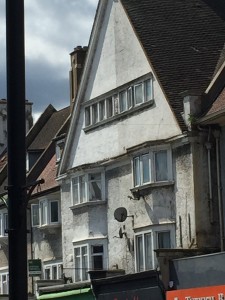 The effect he achieved in our humble home streets must be pretty much unique in the UK. The parade on Green Lanes from the Triangle to Devonshire Road, originally known as ‘The Market’, was built in seven stages, inching its way north between 1909 and 1913, and featuring ellipses, balconies and tall steep new Tudor style gables on four storey buildings. Its style was described by Pevsner in Buildings of England (London: North) as ‘Voyseyish’ and the Nat West Bank over the road at 288 ‘a triumphant essay in rusticated brick, with purple and red brick dressings, and dramatically composed chimneys’. (Voyseyish, by the way, is not a Pevsnerish term of abuse, but a reference to the leading arts and crafts architect and designer Charles Voysey). Number 286, built in 1924-5 by comparison is ‘sober’. If you stand in Lodge Drive with a degree of care and an eye out for passing cars, you should be able to contrive to see all three of Sykes’ Palmers Green creations together – the monumental parade, which could admittedly do with a lick or two of paint, no 286 and the ‘sedate 17th century style’ bank.
The effect he achieved in our humble home streets must be pretty much unique in the UK. The parade on Green Lanes from the Triangle to Devonshire Road, originally known as ‘The Market’, was built in seven stages, inching its way north between 1909 and 1913, and featuring ellipses, balconies and tall steep new Tudor style gables on four storey buildings. Its style was described by Pevsner in Buildings of England (London: North) as ‘Voyseyish’ and the Nat West Bank over the road at 288 ‘a triumphant essay in rusticated brick, with purple and red brick dressings, and dramatically composed chimneys’. (Voyseyish, by the way, is not a Pevsnerish term of abuse, but a reference to the leading arts and crafts architect and designer Charles Voysey). Number 286, built in 1924-5 by comparison is ‘sober’. If you stand in Lodge Drive with a degree of care and an eye out for passing cars, you should be able to contrive to see all three of Sykes’ Palmers Green creations together – the monumental parade, which could admittedly do with a lick or two of paint, no 286 and the ‘sedate 17th century style’ bank.
Sykes had already headed north before his work was done in Palmers Green, partnering with Bill Stocks of Huddersfield, getting involved in the creation of Alwoodly Golf Club in Leeds and becoming an alderman of Huddersfield, where he died in 1940. If you are visiting, you can still see the Sykes designed and grade 2 listed Empire Cinema, at 80 John William Street. Though judging by my internet search this afternoon I am afraid it appears to be a sex shop.
- This article has been prepared as part of the process to nominate buildings and landmarks to Enfields updated local list. For more information see http://www.palmersgreenn13.com/2015/09/11/every-street-in-palmers-green/
